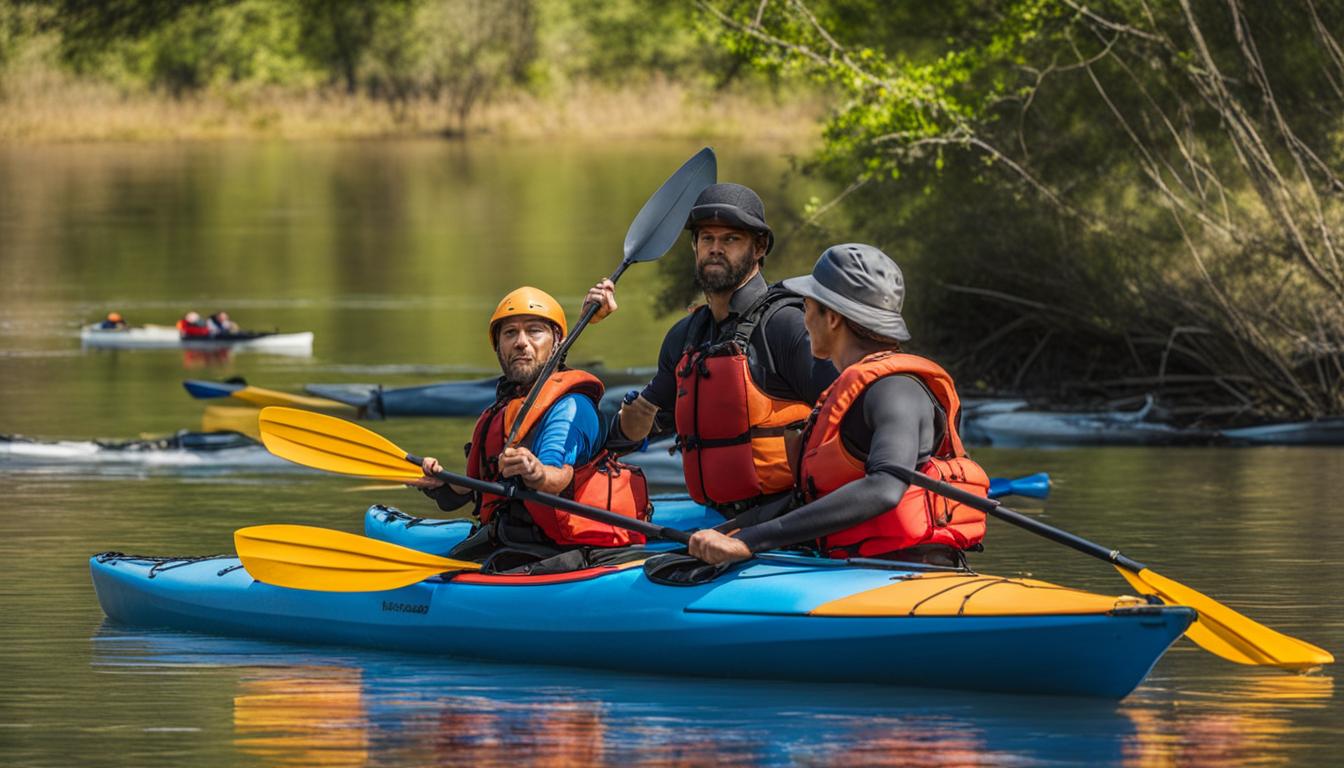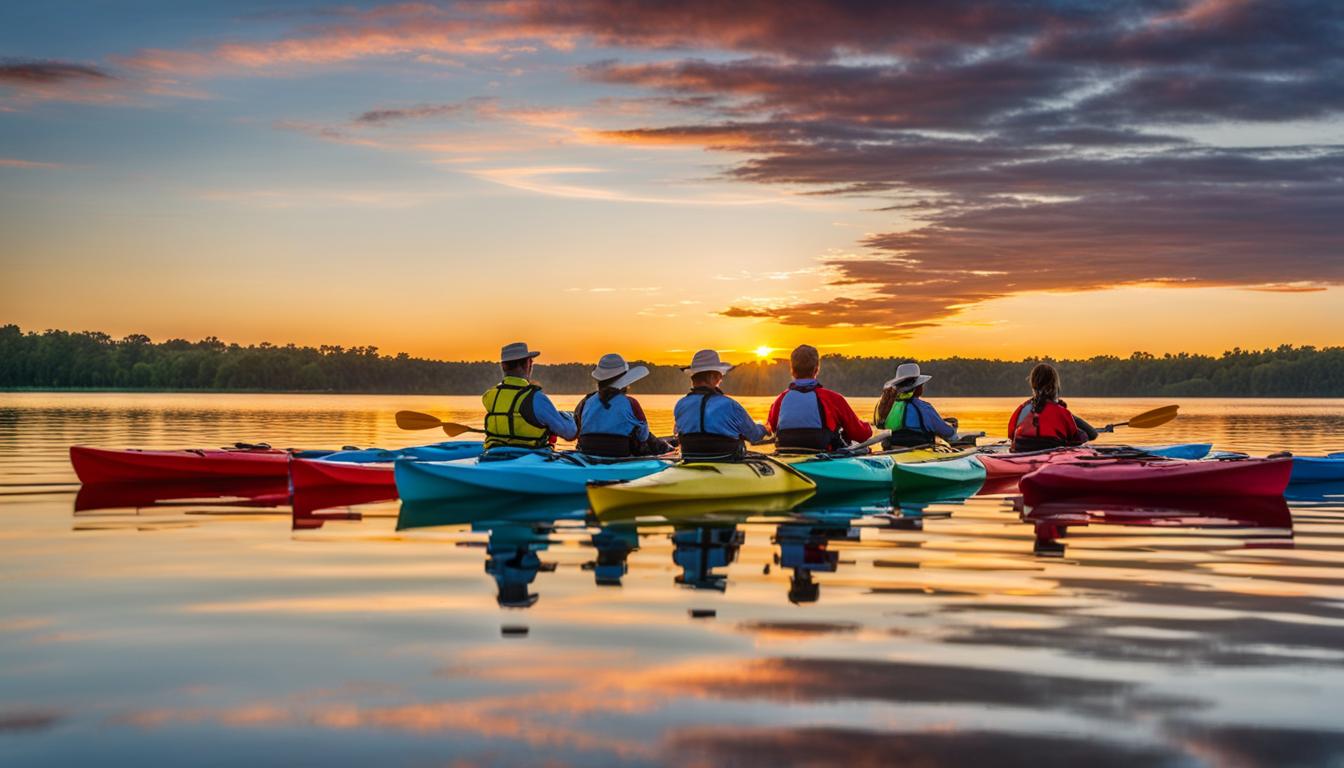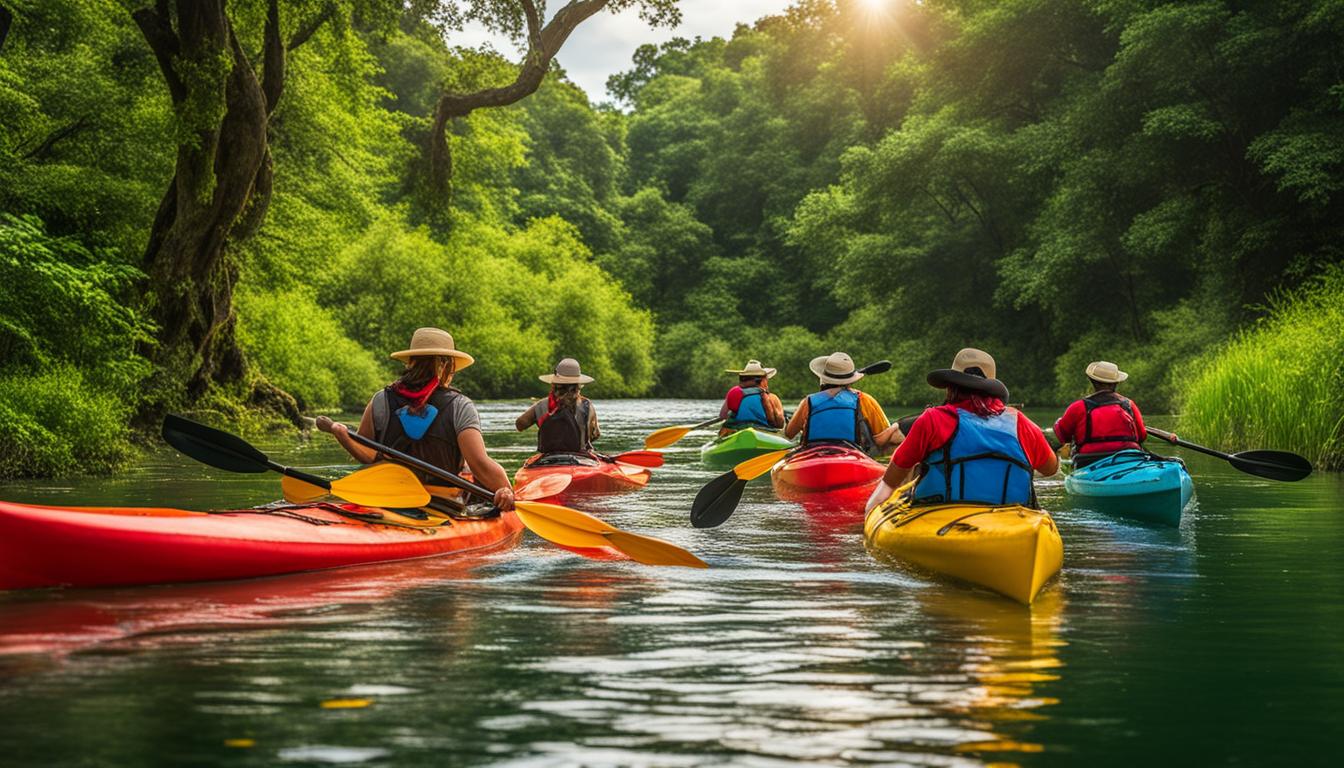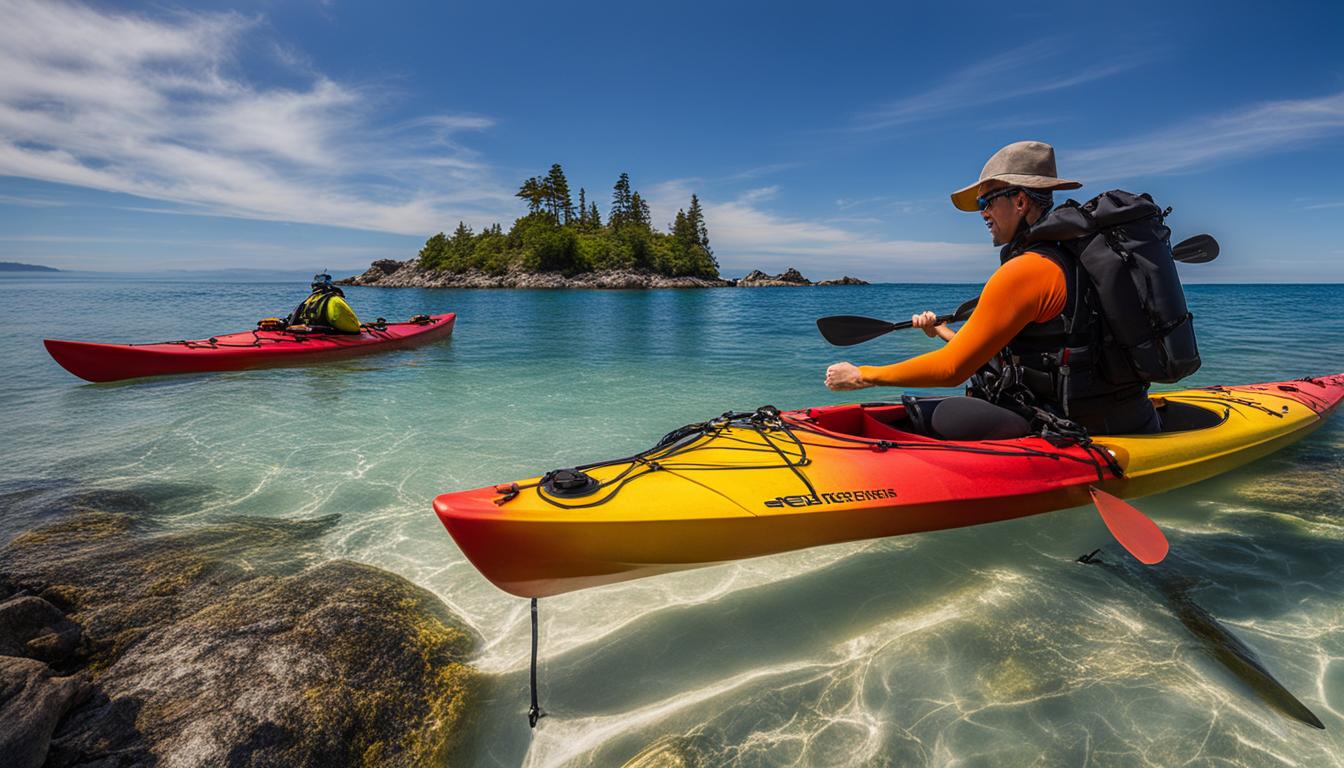When you’re planning a kayaking adventure, safety should always be your top priority. Before you set off on the water, it’s essential to take a few moments to ensure that the kayak you’re renting is in good condition and equipped with the necessary safety features. By following these kayak rental safety checks and inspection tips, you can enjoy your experience with peace of mind.
Key Takeaways:
- Thoroughly assess the condition of the kayak, checking for any damages that may affect its functionality.
- Test additional features such as hatches, skegs, or rudders to ensure they are working properly.
- Verify that the kayak has reliable grab loops, deck lines, and no leaks in the bulkheads or flotation bags.
- Inquire about additional safety equipment like wetsuits, compasses, paddle floats, and helmets that may be available for rent.
- Always check the weather conditions, considering factors like tides, currents, wind direction, and speed.
Assessing Kayak Rental Equipment
Before renting a kayak, it is crucial to thoroughly inspect the equipment. Checking the condition and maintenance of the kayak is essential to ensure a safe and enjoyable experience. Here are some key steps to evaluate the kayak rental safety:
1. Check the kayak’s physical condition:
Inspect the kayak for any major damages or signs of wear and tear. Look for cracks, dents, or holes that could compromise the structural integrity of the kayak. Ensure that the kayak’s hull is intact and free from any significant damage that may affect its performance on the water.
2. Test additional features:
Verify that all additional features of the kayak are in proper working order. This includes hatches, skegs, rudders, and any other adjustable components. Test their functionality to ensure they are operable and secure. If any feature is not functioning correctly, ask the rental provider to provide an alternative kayak or repair the issue before proceeding.
3. Check safety equipment:
Ensure that the kayak is equipped with reliable grab loops and deck lines. These safety features are essential for rescue and self-rescue situations. Additionally, check for any leaks in the bulkheads and flotation bags, as these can affect the kayak’s buoyancy and stability. Inquire about the availability of additional safety equipment for rent, such as dry or wetsuits, compasses, paddle floats, and helmets, and assess their condition as well.
By carefully assessing the kayak rental equipment before your adventure, you can minimize the risk of any unforeseen issues and enjoy your time on the water with peace of mind.
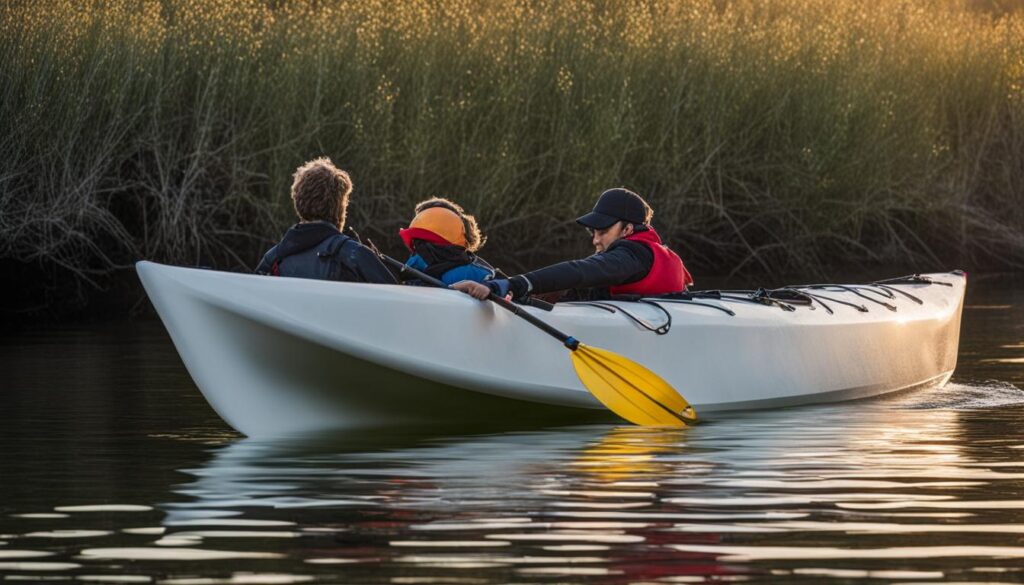
Table: Kayak Rental Equipment Assessment Checklist
| Equipment | Condition | Action Required |
|---|---|---|
| Kayak Hull | Intact without major damage | N/A |
| Hatches | Secure and functional | N/A |
| Skegs/Rudders | Operable and secure | N/A |
| Grab Loops and Deck Lines | Reliable and in good condition | N/A |
| Bulkheads and Flotation Bags | No leaks | N/A |
| Add-on Safety Equipment | Functional and in good condition | N/A |
Note: N/A – No action required if the equipment is in good condition and functioning properly.
Kayak Rental Safety Guidelines
When renting a kayak, it is important to not only focus on the equipment but also consider external factors such as weather conditions and rental policies. By checking these aspects, you can ensure a safe and enjoyable kayaking experience. Here are some guidelines to keep in mind:
Checking Weather Conditions
Before embarking on your kayak rental adventure, it is crucial to assess the weather conditions. Pay attention to factors such as wind speed, tides, and currents, as they can have a significant impact on your safety. You can consult weather reports and marine forecasts to gather information about the expected weather conditions in the area where you plan to kayak. It is always better to be prepared and wait for favorable weather conditions rather than risking your safety in unfavorable conditions.
Familiarize Yourself with Rental Policies
Each kayak rental company may have different policies and safety guidelines. It is important to familiarize yourself with these policies before renting a kayak. Check if there are any specific safety equipment standards that you need to follow. Some companies may require you to wear a life jacket at all times, while others may have additional safety equipment available for rent. By understanding and adhering to these policies, you can ensure that you are renting a kayak from a reputable company that prioritizes your safety.
Summary
When renting a kayak, it is crucial to consider safety measures beyond just the equipment. Checking weather conditions and familiarizing yourself with rental policies can help ensure a safe and enjoyable kayaking experience. Always prioritize your safety and follow the guidelines set by the rental company. By doing so, you can fully enjoy the beauty of kayaking while keeping yourself protected.
Prioritizing Safety and Preparedness
Ensuring your safety and preparedness is paramount when renting a kayak. By taking the following safety checks into consideration, you can have a worry-free and enjoyable kayaking experience.
Get Familiar with Kayak Safety Policies
Before embarking on your kayaking adventure, it is essential to familiarize yourself with the safety policies provided by the rental shop. Understand the rules and regulations governing the use of rented kayaks, including age restrictions, life jacket requirements, and navigation guidelines. By adhering to these policies, you can ensure the safety of yourself and others on the water.
Inspect the Kayak Thoroughly
Prior to heading out on the water, conduct a thorough inspection of the rented kayak. Check for any damages or signs of wear that may affect its performance. Ensure that all components, such as hatches, skegs, and rudders, are in proper working condition. Test the grab loops and deck lines to ensure they are secure. Additionally, inspect for any leaks in the bulkheads and flotation bags. By thoroughly inspecting the kayak, you can identify and address any potential issues before they become safety hazards.
Prepare for Emergencies
Accidents can happen, even when precautions are taken. It is crucial to be prepared for emergencies by carrying essential safety equipment. This may include a first aid kit, a whistle or signaling device, a marine radio or cell phone in a waterproof case, and a paddle float for self-rescues. Additionally, it is recommended to have some knowledge of basic kayaking rescue techniques or take a safety and rescue course before renting a kayak. By being prepared and equipped with the necessary tools, you can respond effectively in case of an emergency.
Remember, safety should always be your top priority when renting a kayak. By familiarizing yourself with the rental shop’s safety policies, conducting a thorough inspection of the equipment, and being prepared for emergencies, you can ensure a safe and enjoyable kayaking experience.
Conclusion
Ensuring the safety of your kayaking adventure is of utmost importance. By following these kayak rental safety guidelines, you can have a secure and enjoyable experience.
First, be meticulous in your safety checks for rented kayaks. Assess the kayak’s condition, checking for any damages that may affect its functionality. Test additional features such as hatches, skegs, or rudders, and make sure grab loops and deck lines are reliable. Don’t forget to look for any leaks in the bulkheads and flotation bags. Consider renting additional safety equipment like dry or wetsuits, compasses, paddle floats, and helmets.
In addition to checking the equipment, always stay aware of the weather conditions. Tides, currents, wind direction, and speed can have a significant impact on your safety and enjoyment. Consult weather reports and marine forecasts to prepare accordingly.
Lastly, prioritize your safety and preparedness. If you’re inexperienced or unfamiliar with the location, take lessons or opt for guided trips. Wear a properly fitted life jacket at all times and familiarize yourself with local laws and regulations. Always remember to enjoy your kayaking adventure responsibly.
FAQ
What should I check when renting a kayak?
It is important to thoroughly inspect the kayak for any damages, test additional features, and check for reliable grab loops and deck lines. Inquire about available safety equipment and check for leaks or damage to bulkheads and flotation bags.
How should I assess the weather conditions before kayaking?
Consult weather reports and marine forecasts to stay informed about tides, currents, wind direction, and speed. This will help you prepare for your journey and make informed decisions about safety.
Should I take lessons or opt for guided trips if I am inexperienced?
Yes, it is recommended to take lessons or choose guided trips if you are inexperienced or unfamiliar with the location. Most rental shops provide maps to prevent getting lost.
Should I wear a life jacket when kayaking?
Yes, it is crucial to always wear a life jacket, even if it feels uncomfortable at first. Ensure it fits properly and check local laws and regulations regarding life jacket usage, age restrictions, and navigation rules.
How can I ensure a secure and enjoyable kayaking adventure?
By following the safety measures outlined above, such as assessing rental equipment, checking weather conditions, familiarizing yourself with policies, wearing a life jacket, and prioritizing safety and preparedness, you can ensure a secure and memorable kayaking experience.

